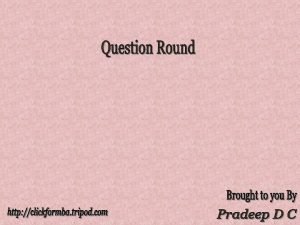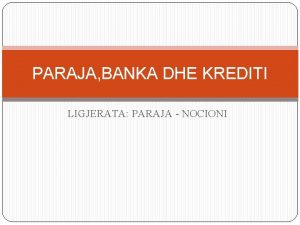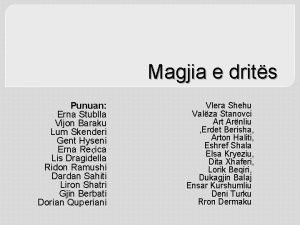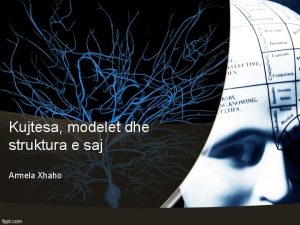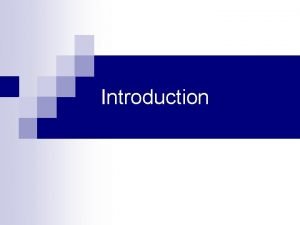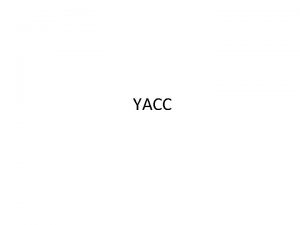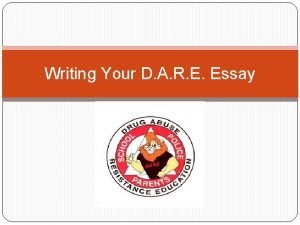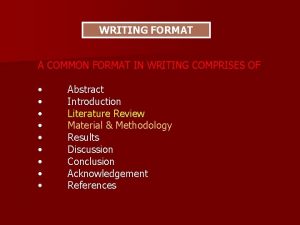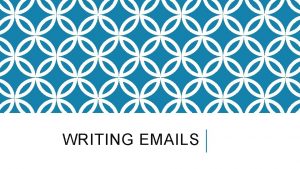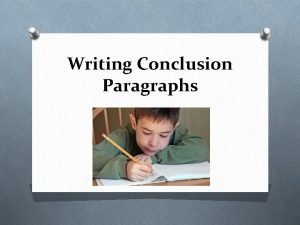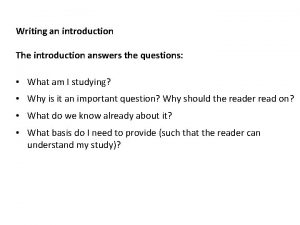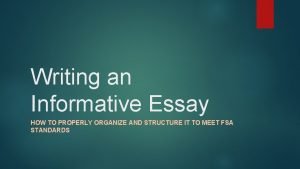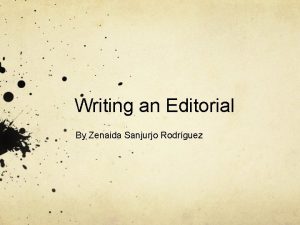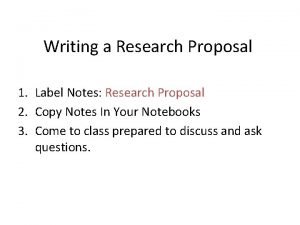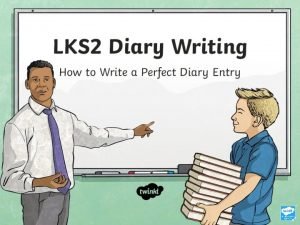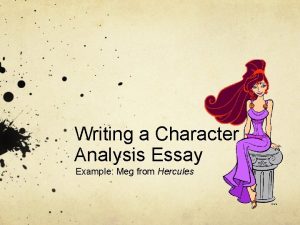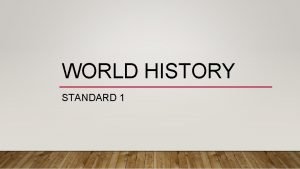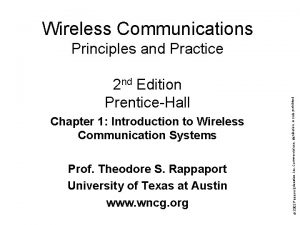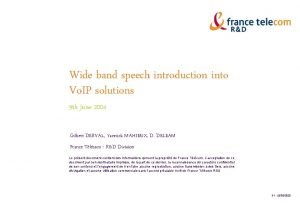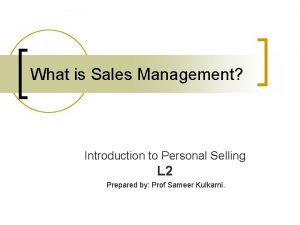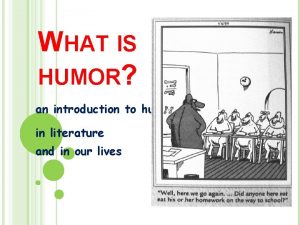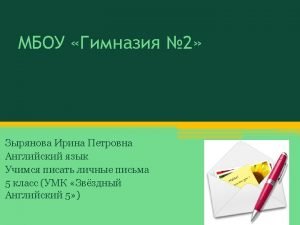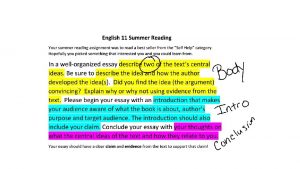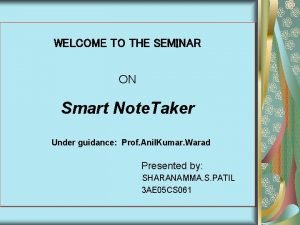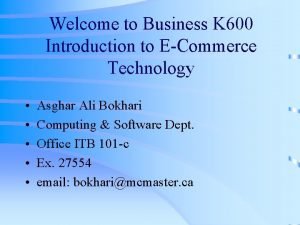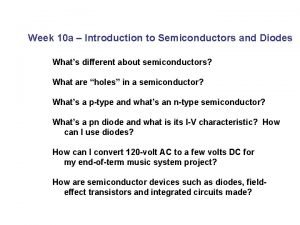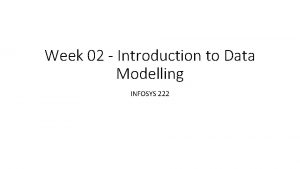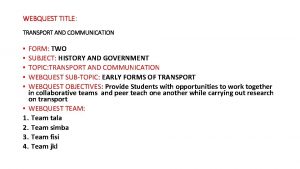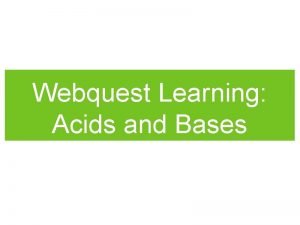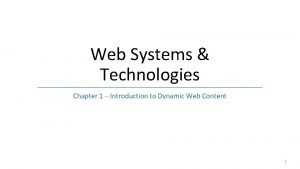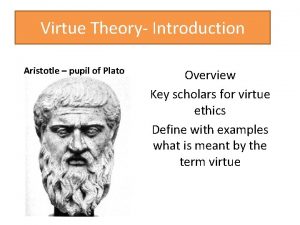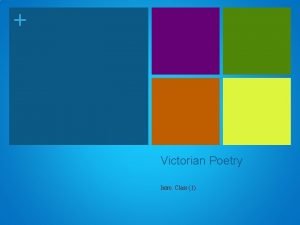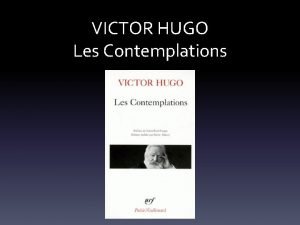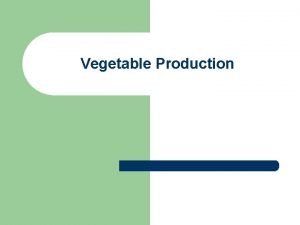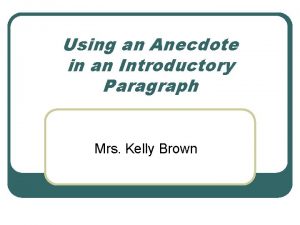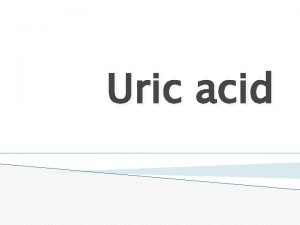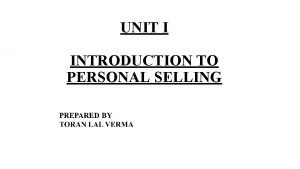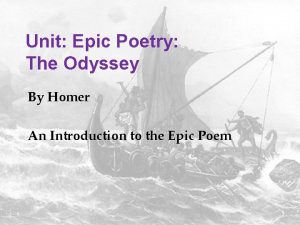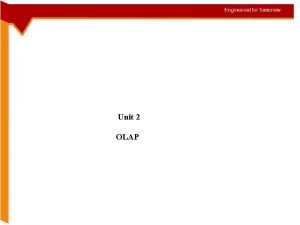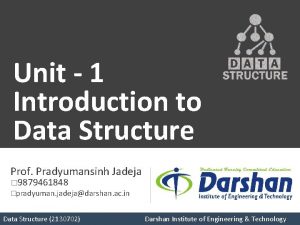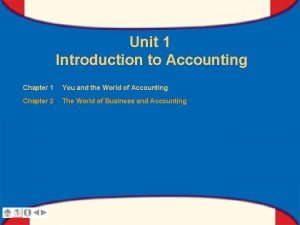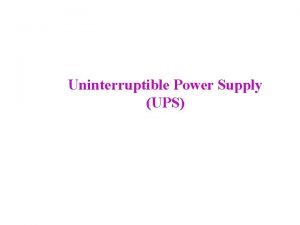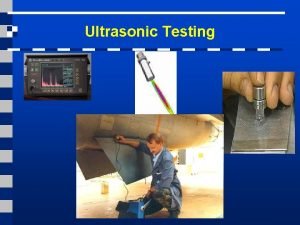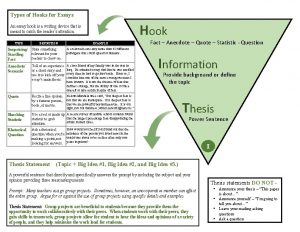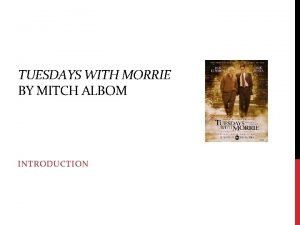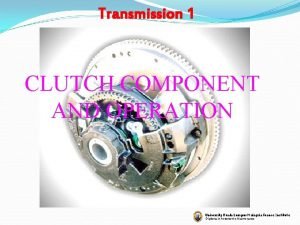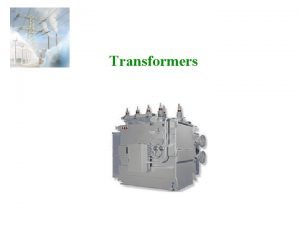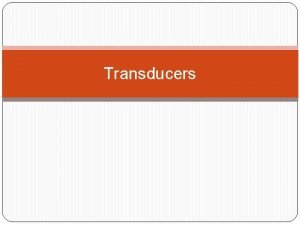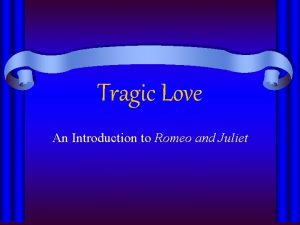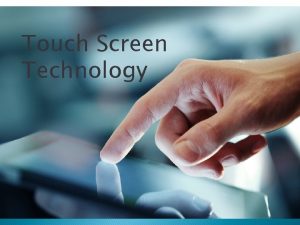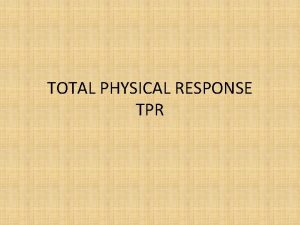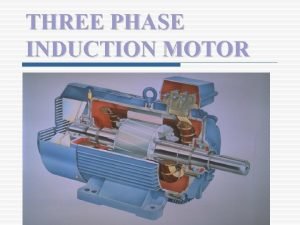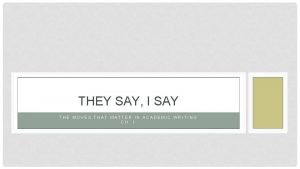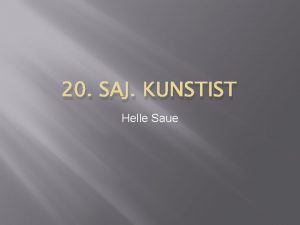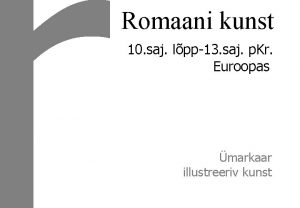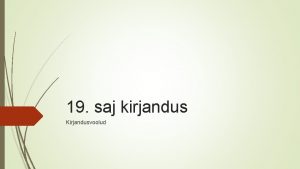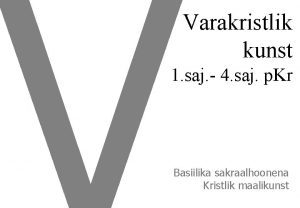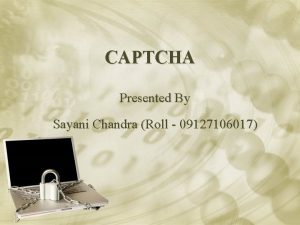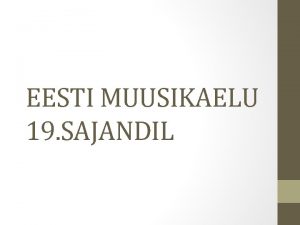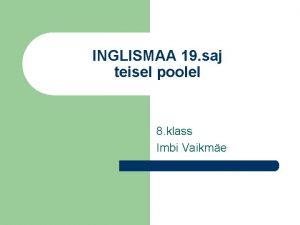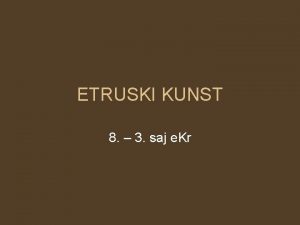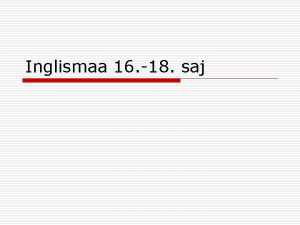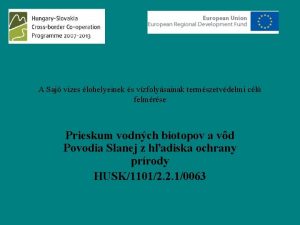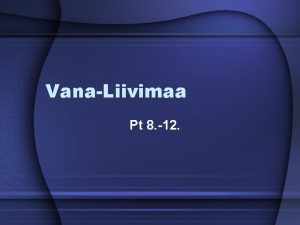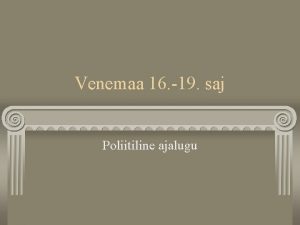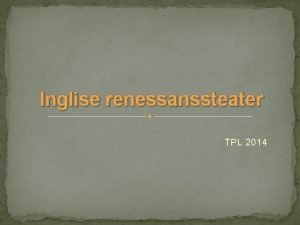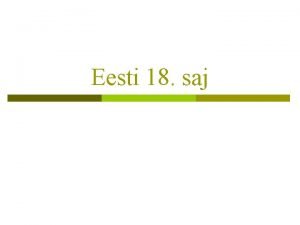Introduction Who am I n Saj Sayani n









































































- Slides: 73

Introduction

Who am I n Saj Sayani ¨ ¨ ¨ n n IT Consultant Working with BT ¨ n BA Hons MBA Ci. M Delivering Large Call Centre Infrastructure Projects Background in ¨ ¨ ¨ Business Consultancy IT Consultancy Business Process Engineering End to End delivery of IT and related systems Telecoms and Call Centre Infrastructure Specialist

Former Employers clients n n n n n HP / Agilent Eli-Lilly Digital (Compaq) Barclays Lloyds. TSB PA Consulting Ernst and Young Unisys Halifax (HBOS) Cisco n n n n n West Bromwich Building Society De Montfort University Reuters Credit Suisse (CSFB) ICL (Fujitsu) Chase Manhattan Bank Avaya Nortel Loughborough University

About yourselves n Take 5 minutes to prepare ¨ One minute from each attendee on Who are you n Where are you from n What you do n Why you are here n What do you want to get out of this n ¨ List Objectives

Exercise – Ice Breaker 1 Split into 2 groups n Business Game n ¨ Each team has 100 Points ¨ Each team selects a leader ¨ We play 10 rounds After 3 rounds we have negotiation n After 6 rounds we have negotiation n After 8 rounds we have negotiation n

Exercise – Ice Breaker 2 n 2 options to choose ¨ Option n A B Scoring is as follows ¨ Team A selects Option A and Team B Selects option A – Team A gets 25 points Team B gets 0 points ¨ Team B selects Option B and Team A Selects option B – Team B gets 25 points Team A gets 0 points ¨ Both Teams Select different options – then both lose 10 points

Scoring Round 1 2 3 4 5 6 7 8 9 10 Choice Team A Choice Team B Team A Points Team B Points

Exercise – Ice Breaker Conclusion n n Naturally we are competitive and want to win But if we understand that if we both give a little we can both win Moral is Work together and you both win Examples ¨ Trade Union Negotiations ¨ Diplomatic Discussions ¨ Cold War (MAD)

Business Strategy

Corporate Culture n The beliefs and values shared by people who work in an organisation ¨ How people behave with each other ¨ How people behave with customers/clients ¨ How people view their relationship with stakeholders ¨ People’s responses to energy use, community involvement, absence, work ethic, etc. ¨ How the organisation behaves to its employees – training, professional development, etc.

Corporate Culture May be driven by: n Vision – where the organisation wants to go in the future n Mission Statement – summary of the beliefs of the organisation and where it is now n

Corporate Culture n May be reflected in: ¨ Attitude and behaviour of the leadership ¨ Attitude to the role of individuals in the workplace – open plan offices, team based working, etc. ¨ Logo of the organisation ¨ The image it presents to the outside world ¨ Its attitude to change

Exercise Split into groups of 3 -4 n Spend 15 Minutes thinking of examples of Corporate culture n Presentation from each group n

Corporate Culture What corporate culture do you think the following businesses have managed to develop?

Strategic Planning n n First Stage of Strategic Planning may involve: Futures Thinking ¨ n Strategic Intents ¨ n Thinking about what the business might need to do 10– 20 years ahead Thinking about key strategic themes that will inform decision making “The thicker the planning document, the more useless it will be” ¨ (Brent Davies: 1999) Taking time to think and reflect may be more important than many businesses allow time for!

Strategic Planning n The Vision ¨ Communicating to all staff where the organisation is going and where it intends to be in the future ¨ Allows the firm to set goals n Aims and Objectives: ¨ Aims – long term target ¨ Objectives – the way in which you are going to achieve the aim

Strategic Planning n n n Example: Aim may be for a PC manufacturer to break into a new overseas market Objectives: ¨ Develop relationships with overseas suppliers ¨ Identify network of retail outlets ¨ Conduct market research to identify consumer needs ¨ Find location for overseas sales team HQ

Strategic Planning n Once the direction is identified: ¨ Analyse position ¨ Develop and introduce strategy ¨ Evaluate: n Evaluation is constant and the results of the evaluation feed back into the vision

Types of Strategy n n Competitive Advantage – something which gives the organisation some advantage over its rivals Cost advantage – A strategy to seek out and secure a cost advantage of some kind - lower average costs, lower labour costs, etc.

Types of Strategy n Market Dominance: ¨ Achieved through: n n n Internal growth Acquisitions – mergers and takeovers New product development: to keep ahead of rivals and set the pace n Contraction/Expansion – focus on what you are good at (core competencies) or seek to expand into a range of markets?

Types of Strategy n n n Price Leadership – through dominating the industry – others follow your price lead Global – seeking to expand global operations Reengineering – thinking outside the box – looking at new ways of doing things to leverage the organisation’s performance

Types of Strategy n Internal business level strategies – ¨ Downsizing – selling off unwanted parts of the business – similar to contraction ¨ Delayering – flattening the management structure, removing bureaucracy, speed up decision making ¨ Restructuring – complete re-think of the way the business is organised

Exercise Split into groups of 3 -4 n Spend 30 Minutes thinking of n ¨ Business Idea (Examples = Car Manufacturer, Airline, Software Company…. ) ¨ Corporate Culture to go with it ¨ Strategy to get the business started and moving n Presentation from each group

Strategic Market Analysis SWOT n n Strengths – identifying existing organisational strengths Weaknesses – identifying existing organisational weaknesses Opportunities – what market opportunities might there be for the organisation to exploit? Threats – where might the threats to the future success come from?

PEST n n Political: local, national and international political developments – how will they affect the organisation and in what way/s? Economic: what are the main economic issues – both nationally and internationally – that might affect the organisation? Social: what are the developing social trends that may impact on how the organisation operates and what will they mean for future planning? Technological: changing technology can impact on competitive advantage very quickly!

PEST n Examples: ¨ ¨ ¨ ¨ Growth of China and India as manufacturing centres Concern over treatment of workers and the environment in less developed countries who may be suppliers The future direction of the interest rate, consumer spending, etc. The changing age structure of the population The popularity of ‘fads’ like the Atkins Diet The move towards greater political regulation of business The effect of more bureaucracy in the labour market

Case Study Read the Highways Agency Case Study n Demonstrates how PEST works in real life n

Five-Forces n Developed by Michael Porter: forces that shape and influence the industry or market the organisation operates in. ¨ Strength of Barriers to Entry - how easy is it for new rivals to enter the industry? ¨ Extent of rivalry between firms – how competitive is the existing market? ¨ Supplier power – the greater the power, the less control the organisation has on the supply of its inputs. ¨ Buyer power – how much power do customers in the industry have? ¨ Threat from substitutes – what alternative products and services are there and what is the extent of the threat they pose?

Required Inputs n n Changing strategy will impact on the resources needed to carry out the strategy: Specifically the impact on: ¨ Land – opportunities for acquiring land for development – green belt, brownfield sites, planning regulations, etc. ¨ Labour – ease of obtaining the skilled and unskilled labour required ¨ Capital – the type of capital and the cost of the capital needed to fulfil the strategy

Evaluation n Data from sales, profit, etc. used to evaluate the progress and success of the strategy and to inform of changes to the strategy in the light of that data Information from a wide variety of sources can help to measure and inform the impact and direction of the strategy.

Conclusion n Strategy ¨ Drives how n the business – i. e. what do we want to do and Customer ¨ Understand our customer and his needs and base our products / services to meet those needs n Support the business with ¨ People ¨ Process ¨ Technology

Exercise Split into groups of 3 -4 n Spend 30 Minutes taking your business idea above and identify n ¨ What your business needs in terms of support (People, Process, Technology) to achieve its strategy and culture n Presentation from each group

Business Support – People, Process, Technology r Tec hn e tom olog Cus y Strategy Pe op le Pr s s e oc

IT in the Business Place

Agenda Role of technology in business n Increasing importance of technology n

Exercise Split into groups of 3 -4 n Spend 30 Minutes thinking of n ¨ What is IT and how is it used ¨ List everything you can think of Everyday examples n Examples at work n n Presentation from each group

Technology Milestones n n n n 1972 first electronic slide rule 1980 very few execs use PCs 1986 NSFNetonline (National Science Foundation NETwork) 1990 WWW created, 1 st. US digital cell phone call 1991 NSF allows commercial use 1995 NSFNetdecommissioned March 10, 2000 Internet bubble max diameter

Role of Technology in Business n Support Business Operations ¨ ¨ ¨ n Enable Business Innovations ¨ ¨ ¨ n Databases Enterprise communication and Management (E-mail…) Information Systems Management Information Point of Sale (POS / EPOS systems) New channels, new services Improved customer experience Global supply chain Management Regulatory Compliance ¨ ¨ Rules and Regulations PCIDSS Example

Exercise Split into groups of 3 -4 n Spend 30 Minutes thinking of n ¨ What sort of IT will you require to support your business above ¨ List everything you can think of n Presentation from each group

Increasing Importance of Technology n Increasing technology dependence ¨ Customer expectations have changed ¨ New customer-centric focus ¨ To gain a competitive edge n n No room for failure – if your business model is IT based e. g. E-Bay, Easyjet, Banking (RBS)…. Increasing complexity ¨ Different ¨ Security Technologies co-existing

Exercise Split into groups of 3 -4 n Spend 30 Minutes thinking of n ¨ Key n issues in the IT required by your business Presentation from each group

Key Issues in IT n Security ¨ ¨ ¨ n Reliability ¨ ¨ n n n Systems Data Processes BCP (Business Continuity Planning) DR (Disaster Recovery) Availability Scalability Compliance ¨ Legislation e. g. Data Protection

The Business Dimensions Model r Tec e tom hno Cus logy Strategy Pe op le Source : - Call. Care Consulting © 2006 s s e P c o r

Each axis is used to provide a comprehensive measure of progress toward implementing the Vision Strategy Measures “To succeed, how should we appear to our shareholders? ” M T W Profitability Growth Technology Measures Pe People Measures “To achieve our strategy how will we sustain our ability to change and improve? ” M Innovation Learning Intelligence Source : - Call. Care Consulting © 2006 “To achieve our strategy, how must we appear to our customer’s? ” er Utilisation W hno T Tec M Quantity Capacity Customer Measures tom “To support our strategy how can we best leverage technology? ” Cus logy Value Strategy T W op le P ro ss e c M Quality Efficiency Accessibility Process Measures “To satisfy our customers, what business processes must we excel at? ” M Time Quality Productivity T W

This approach allows us to identify focused development opportunities with our clients Strategy c hno Tec Source : - Call. Care Consulting © 2006 o Pr r r le e tom op s es Cus Pe logy …and some time later… logy In the beginning… Pe op le Pr o ss e c

IT Purchasing Process

Where does IT Spending Sit ? n CAPEX ¨ Expenditures creating future benefits. A capital expenditure is incurred when a business spends money either to buy fixed assets or to add to the value of an existing fixed asset with a useful life that extends beyond the taxable year n OPEX ¨ on-going system cost for running a product, business, or

Impact on P&L and Balance Sheet n CAPEX ¨ Benefits realised over several years ¨ Has to go on the balance sheet ¨ Is depreciated over several years n OPEX ¨ Is an expense and comes off the P&L

Typical IT Cost Components n CAPEX – typically purchase costs ¨ Hardware n ¨ Software n n ¨ O/S Apps Licences n n n Servers and Kit Per-Seat Based Enterprise Based OPEX – typically running costs ¨ Installation n ¨ PS Charges Maintenance

Exercise – Purchasing Split into groups of 3 -4 n Spend 30 Minutes thinking of n ¨A recent purchasing decision ¨ What factors did you take into account when making the purchase n Presentation from each group

Why Spend on IT ? n Competition ¨ Business Driver (PEST Analysis) n n Regulation Competition Changes in customer dynamics e. g Internet Culture Adds to Bottom Line Productivity Improvements ¨ Saves Money ¨ n To be cutting Edge To have the latest technology ¨ To try and get ahead of competitors ¨

Why Spend on IT ? n Technology Refresh ¨ Upgrades ¨ Replacement of obsolete technology ¨ Replace something that is broken n Fashion ¨A new trend e. g. Call centres were a trend now they are a must have for most organisations who interact with customers

Spending needs to be assessed n Analyse costs and benefits ¨ Ongoing costs ¨ Running costs ¨ Savings and benefits n Create a business case for Investment

Case Study – Blackberry Read the Black. Berry Case study n Spend 15 minutes identifying n ¨ why a business would want to use this technology ¨ What benefits this brings to the business

Key Terms n Leading Edge ¨ n The latest technology Bleeding Edge Refers to technology that is so new (and thus, presumably, not perfected) that the user is required to risk reductions in stability and productivity in order to use it. It also refers to the tendency of the latest technology to be extremely expensive ¨ The latest technology ¨ But it is unproven i. e. you would be a guinea pig ¨ n n High Risk Future Proofing ¨ ¨ This is a Panacea Technology Moves on so this is not really possible

Why ROI? n n n Large amounts of money involved Competition with other investment opportunities Ensure full validation of project prior to initiation Identification of opportunities to structure project to achieve interim benefits quicker Detailed documentation to improve milestone and post implementation reviews

Investment Analysis Is a Fiduciary Responsibility Understand Financial Impact of Projects Select Best from Many Alternatives Protect Interests of business & Investors

Financial Analysis Quantifies Investment Value Do benefits outweigh costs? By how much? How long before we see a return? How confident are we in the financial projections? Are there better alternatives for our money?

Shifting ROI Landscape n n Traditional models were based on labor savings by implementing technology Organizations are much leaner now and often have existing systems, resulting in less incremental benefits available ROI should now focus on the financial statement drivers and corporate strategies Current “hot buttons” ¨ ¨ ¨ Lean Operations (eliminate waste/shorten cycle times) Compliance Tracking Reliability Centered maintenance Asset Management Optimization of Material

When Should You Do ROI? Strategy Development n Project Initiation n Project Detailed Design completion n Project completion n When in operation for some time n When assessing replacement of the tool n

Quantitative Measures Subtract Costs from Benefits Cumulative Benefits Equal Cumulative Costs NPV Break Even ROI Divide Benefits by Cost Pay Back Time from Now to Breakeven Point

Each Measure Has a Best Use n NPV Best overall measure of financial value ¨ Higher NPV always identifies better investment ¨ n ROI Shows whether benefits outweigh costs ¨ Inappropriate for comparing investments (can have high ROI with low NPV, etc. ) ¨ n Breakeven Point and Payback Period Shows whether benefits outweigh costs ¨ Important political measure ¨ Inappropriate for comparing investments ¨

ROCE = Pre-Tax Op. Profit / Capital employed Shows how effectively a company is using its capital e. g. a company with lots of assets (e. g. Land) with a small profit has a low ROCE, a small internet company with low assets may make a large ROCE

NPV 1 NPV = Rt / (1+i)^t R = Net Cash Flow t = Time i = Discount Rate (return that could be achieved elsewhere)

NPV 2 Year Cash Flow 0 E. g. £ 100, 000 spent on machinery Return = £ 30, 000 pa Running Cost = £ 5, 000 pa Period = 6 years i = 10% Total NPV = 8, 881. 52 -100, 000/(1+0. 10)^0 PV -100, 000 1 (30, 000 -5, 000) /(1+0. 10)^1 22, 727 2 (30, 000 -5, 000) /(1+0. 10)^2 20, 661 3 (30, 000 -5, 000) /(1+0. 10)^3 18, 783 4 (30, 000 -5, 000) /(1+0. 10)^4 17, 075 5 (30, 000 -5, 000) /(1+0. 10)^5 15, 523 6 (30, 000 -5, 000) /(1+0. 10)^6 14, 112

Case Study 2 – Mc. Cain Read the Mc. Cain Case study n Spend 30 minutes identifying n ¨ why a business would want to use this approach ¨ What benefits this brings to the business

Investment Analysis Process STEP 6 Prepare STEP 5 Strategic Analysis Perform STEP 4 Financial Analysis Schedule STEP 3 Cash Flows Calculate STEP 2 Tangible Benefits Calculate STEP 1 Costs Define the Investment

Describe & Quantify All Costs n Capital/One-time Costs Hardware & Software ¨ Data Acquisition & Conversion ¨ Start-up Services ¨ n Operating/Ongoing Costs ¨ ¨ ¨ New Hires Salary Adjustments Hardware & Software Maintenance Training Support Services Data License Fees

Typical System Costs n n n n Hardware integration with pre-existing computing infrastructure Evaluation, selection, acquisition and installation of software Undertaking requirements/needs analysis Contractual aspects systems customization Applications portfolio development Interfacing to other ‘data servers’ and operational systems n n n n n Business case analysis Project management Delivery and installation Business process reengineering Transitional costs (i. e. parallel running of old and new systems) On-going cost implications (i. e. staff costs and consumables) Data purchase Data capture, data conversion Data re-survey and validation Training, human resources planning, skills development and re-skilling

Applications Drive Benefits Increase productivity n Add revenue source/enhance collection n Reduce fee/fine n Eliminate a service, building, or process n

Strategic Analysis Looks Beyond The Money Competitive Advantage Goodwill Safety Can We Stay in Business? Morale Regulatory Compliance Clean Environment Growth

Case Study 3 – Cost Savings Read the British Gas Case study n Spend 30 minutes identifying n ¨ What is the business case for this solution ¨ What are the key messages

Exercise Split into groups of 3 -4 n Spend 30 Minutes thinking of n ¨ The IT required by your business and define the cost breakdown of the solutions ¨ Prepare a brief ROI schedule for the purchase Costs n Benefits – quantified where possible n n Presentation from each group
 Rahimullah sayani
Rahimullah sayani Deluzione
Deluzione Drogat dhe pasojat
Drogat dhe pasojat Si perhapet tingulli ne uje
Si perhapet tingulli ne uje Rendesia e parase
Rendesia e parase Pasqyrimi i drites wikipedia
Pasqyrimi i drites wikipedia Kujtesa episodike
Kujtesa episodike E saj am
E saj am Intro paragraph outline
Intro paragraph outline Learning without burden pdf
Learning without burden pdf Introduction to yacc
Introduction to yacc Dare essay introduction
Dare essay introduction Academic writing introduction
Academic writing introduction Abstract vs introduction
Abstract vs introduction How long is a introduction
How long is a introduction Email writing topics
Email writing topics Bridge introduction paragraph
Bridge introduction paragraph Introduction answer the question
Introduction answer the question How to write a thesis for an informative essay
How to write a thesis for an informative essay Introduction of editorial
Introduction of editorial Advantages and disadvantages essay b1
Advantages and disadvantages essay b1 Introduction for research proposal
Introduction for research proposal How do you write a diary entry
How do you write a diary entry Character review example
Character review example Schaffer paragraphs
Schaffer paragraphs Conclusion for mesopotamian civilization
Conclusion for mesopotamian civilization Barangay work immersion
Barangay work immersion Wireless communication introduction
Wireless communication introduction Band introduction speech
Band introduction speech Sales management introduction
Sales management introduction What is humor
What is humor Introduction for informal email
Introduction for informal email Thematic essay example
Thematic essay example What are the qualities of a good sentence
What are the qualities of a good sentence Working of smart note taker
Working of smart note taker Introduction to e business
Introduction to e business Introduction to semiconductors
Introduction to semiconductors Introduction of infosys
Introduction of infosys How is water transported in humans
How is water transported in humans Acids and bases webquest
Acids and bases webquest Introduction to dynamic web content
Introduction to dynamic web content Pollution introduction
Pollution introduction Pupil
Pupil Introduction of purification of water
Introduction of purification of water Victorian poetry introduction
Victorian poetry introduction Characteristics of victorian age
Characteristics of victorian age Victor hugo introduction
Victor hugo introduction Vegetable production introduction
Vegetable production introduction Anecdote paragraph example
Anecdote paragraph example Introduction of urinary system
Introduction of urinary system Hypourecemia
Hypourecemia Types of selling situations in personal selling
Types of selling situations in personal selling Famous epic poem by homer
Famous epic poem by homer Introduction to olap
Introduction to olap Enduring issues
Enduring issues Data structures unit 1
Data structures unit 1 Introduction to computer organization and architecture
Introduction to computer organization and architecture Unit 1 introduction to accounting
Unit 1 introduction to accounting Ups
Ups Application of ultrasonic inspection
Application of ultrasonic inspection Types of hooks in english
Types of hooks in english Cro working
Cro working Introduction of tuesdays with morrie
Introduction of tuesdays with morrie Introduction of clutch
Introduction of clutch Transistor ie=ib+ic
Transistor ie=ib+ic Introduction to transformer
Introduction to transformer Introduction to transducers
Introduction to transducers Romeo and juliet a tragic love story
Romeo and juliet a tragic love story Introduction to traffic management
Introduction to traffic management Touch screen introduction
Touch screen introduction Introduction of tpr
Introduction of tpr How induction motor starts
How induction motor starts They say, i say examples
They say, i say examples Introduction to thermochemistry
Introduction to thermochemistry
